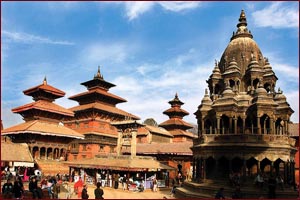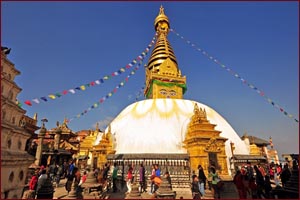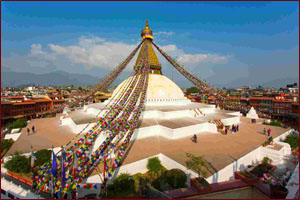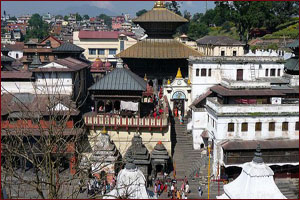Scenic Kathmandu: 4 Days / 3 Nights
Validity: – Valid till 30th Sept'18
Day 01: Arrival in Kathmandu
 Upon arrival at the airport, welcome by our representative & transfer to the Hotel. At the hotel briefing about the program by our representative. In the evening, enjoy optional traditional Nepalese Dance with Dinner at Nepali Chulo / BanchaGhar / Utsav Restaurant. Rest day at leisure.
Upon arrival at the airport, welcome by our representative & transfer to the Hotel. At the hotel briefing about the program by our representative. In the evening, enjoy optional traditional Nepalese Dance with Dinner at Nepali Chulo / BanchaGhar / Utsav Restaurant. Rest day at leisure.
Day 02: Sightseeing in Kathmandu Valley
Early morning, enjoy optional Mountain Flight for an hour by fixed wing aircraft, the flight shall give you an ariel view of Mt. Everest and other Himalayan Peaks. After breakfast, introduce with the Sightseeing Guide & driver. We set to the first day sightseeing of Kathmandu Valley. This day you will see the following spots;
Patan City:
Patan Durbar Square: Patan Durbar Square is an enchanting mélange of Palace buildings, artistic courtyards and graceful pagoda temples. Listed as a World Heritage Site, the former Royal Palace complex is the center of Patan's religious and social life, and houses a museum containing an array of bronze statues and religious monuments. One remarkable monument here is 17th century temple dedicated to the Hindu god Krishna, built entirely of stone. Tibetan Refugee Camp: This camp was set up in 1960 under the initiative of the International Red Cross & the Swiss Development Corporation in corporation with HMG of Nepal. Its main objective is to help the Tibetan Refugees to do something nice & support themselves & some carpet industries & handicrafts have been operating.
Swoyambhunath : The four seeing eyes of Swoyambhunath Stupa watch over the valley from the top of 77-m high hillock on western side. This most glorious Stupa in the world, is one of the holiest Buddhist sites in Nepal and its establishment is linked to the creation of Kathmandu valley out of a primordial lake. The surroundings of the Swoyambhunath are covered with small Chaityas & monasteries as well as some Hindu temples. The National Museum and the Museum of Natural History are situated at the foot of the hill.
The four seeing eyes of Swoyambhunath Stupa watch over the valley from the top of 77-m high hillock on western side. This most glorious Stupa in the world, is one of the holiest Buddhist sites in Nepal and its establishment is linked to the creation of Kathmandu valley out of a primordial lake. The surroundings of the Swoyambhunath are covered with small Chaityas & monasteries as well as some Hindu temples. The National Museum and the Museum of Natural History are situated at the foot of the hill.
Kathmandu Durbar Square :
This complex of palaces, courtyards and temples, built between 12th and 18th Centuries, used to be the seat of ancient Malla Kings of Kathmandu. It is the place where kings of Nepal are crowned and their coronations solemnized. An intriguing piece here is the 17th century stone inscription set into the wall of the palace with writings in 15 languages. Kumari Temple: Kumari temple is the residence of the Living Goddess. Kumari, known as Virgin Goddess has got some specialties, she must be chosen from a typical Newari cast with no body marks & injuries & will be replaced by another Kumari after puberty. Kasthamandap: Kasthamandap is believed to be constructed from the wood of a single tree in the sixteenth century situated near to the Kumari Temple. The name Kathmandu was named after this temple.
Day 03: Kathmandu  After breakfast, full day sightseeing tour of Kathmandu covering:
After breakfast, full day sightseeing tour of Kathmandu covering:
Bhaktapur City:
Bhaktapur Durbar Square is a conglomeration of pagoda and shikhara-style temples grouped around a fifty-five window palace of brick and wood. The square is one of the most charming architectural showpieces of the Valley as it highlights the ancient arts of Nepal. The golden effigies of kings perched on the top of stone monoliths, the guardian deities looking out from their sanctuaries, the wood carvings in every place-struts, lintels, uprights, tympanums, gateways and windows-all seem to form a well-orchestrated symphony. The main items of interest in the Durbar Square are: The Lion Gate, The Golden Gate, The Palace of Fifty-five Windows, The Art Gallery and The Statue of King BhupatindraMalla.
Boudhanath:
Boudhanath is among the largest stupas in South Asia, and it has become the focal point of Tibetan Buddhism in Nepal. The white mound looms thirty-six meters overhead. The stupa is located on the ancient trade route to Tibet, and Tibetan merchants rested and offered prayers here for many centuries. When refugees entered Nepal from Tibet in the 1950s, many of them decided to live around Bouddhanath. They established many gompas, and the "Little Tibet" of Nepal was born. This "Little Tibet" is still the best place in the Valley to observe Tibetan lifestyle. Monks walk about in maroon robes. Tibetans walk with prayer wheels in their hands, and the rituals of prostration are presented to the Buddha as worshippers circumambulate the stupa on their hands and knees, bowing down to their lord.
Many people believe that Bouddhanath was constructed in the fifth century, but definite proof is lacking. The stupa is said to entomb the remains of a Kasyap sage who is venerable both to Buddhists and Hindus. One legend has it that a woman requested a Valley king for the donation of ground required to build a stupa. She said she needed land covered by one buffalo's skin and her wish was granted by the King. She cut a buffalo skin into thin strips and circled off a fairly large clearing. The king had no choice but to give her the land.
The Bouddha area is a visual feast. Colorful thangkas, Tibetan jewellery, hand-woven carpets, masks, and khukuri knives are sold in the surrounding stalls. Smaller stupas are located at the base. Gompa monasteries, curio shops, and restaurants surround Bouddhanath. Conveniently situated restaurants with roof-top patios provide good food and excellent views of Bouddhanath.
Pashupatinath:
Pashupatinath is the holiest Hindu pilgrimage destination in Nepal. There are linga images of Shiva along with statues, shrines, and temples dedicated to other deities in the complex. A temple dedicated to Shiva existed at this site in AD 879. However, the present temple was built by King BhupatindraMalla in 1697. A gold-plated roof, silver doors, and woodcarvings of the finest quality decorate the pagoda construction. Guheswari Temple, restored in AD 1653, represents the female "force". It is dedicated to Satidevi, Shiva's first wife, who gave up her life in the flames of her father's fire ritual.
A circuit of the Pashupati area takes visitors past a sixth-century statue of the Buddha, an eighth-century statue of Brahma the creator and numerous other temples. Some other places to visit are Rajrajeswari Temple, built in 1407, Kailas with lingas more than 1,400 years old, Gorakhnath temple, and the courtyard of Biswarup. There are rows of Shiva shrines and Hindu pilgrims from all over South Asia offering puja worship to Shiva, tile Lord of Destruction.
The Bagmati River flows close by and the Arya Ghat cremation grounds are here. We strongly advise photographers not to take photos of cremations and of bereaved families. Sadhus, sages who follow the lifestyle of Shiva, may be seen covered in ashes and loin-cloths. They ask for money in case you want to take their photos. The main Pashupatinath courtyard may be entered by those of Hindu faith only.
Day 04: Leave Kathmandu
After breakfast, transfer to the airport to board your onward flight.
